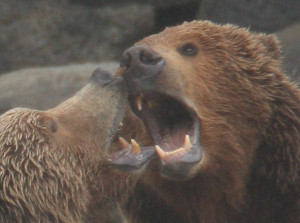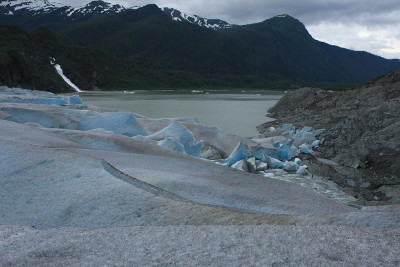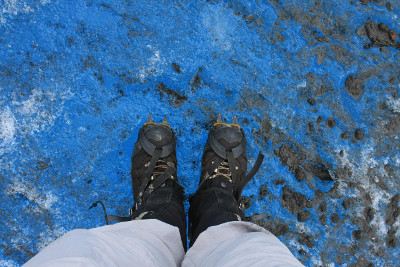

 Share This Page
Share This Page| Home | | Sailing | | Alaska 2013 | |  |  |  Share This Page Share This Page |

Copyright © 2013, P. Lutus. All rights reserved. Message Page
| Prior years: |
Alaska 2002 |
Alaska 2003 |
Alaska 2004 |
Alaska 2005 |
Alaska 2006 Alaska 2007 | Alaska 2008 | Alaska 2009 | Alaska 2010 | Alaska 2011 Alaska 2012 |
(double-click any word to see its definition)

Figure 1: Mendenhall Glacier, facing SE (2008)
|
Figure 3: Same location today, facing NE (2013)
|

Figure 2: Author on the glacier (2008)
|
Figure 4: Glacier monitoring equipment (2013)
|
The reason for the shrinkage is not a mystery — Juneau's average temperature has increased by nearly 3° Fahrenheit (1.6° Celsius) since 1943, and rainfall has increased by 6 inches (15 centimeters) in that time period (source).
Since 2008, just five years ago, the ice has receded several hundred feet, so that if I position myself where I was in 2008, standing on the ice (Figure 1), I am today far removed from the entire glacier (Figure 3).
It's important to understand that the ongoing worldwide climate change, which has had modest effects in the lower 48 states, is having much more dramatic effects in Alaska and other arctic regions. Average temperature change is one of the more dramatic ways that climate change makes itself known in the far north — the rate of change is much higher in Alaska than farther south. The worldwide average temperature increase has been measured as 1.4° Fahrenheit (0.8° Celsius) since 1880 (133 years) (source), but as shown above, Juneau has seen twice that temperature change since 1943 (only 70 years). Expressed another way, southeast Alaska has seen a rate of temperature rise that's almost four times larger than the worldwide average.
There are a number of reasons for this difference. One is the fact that ice- and snow-covered ground reflects much of the sun's warmth back into space, but bare or forested terrain absorbs much more solar energy, thus warming the local climate. This reflection factor creates a "feedback" or amplifying effect — as the temperature rises, more ice and snow melts, and as the surface becomes darker and more receptive to solar energy, this further warms the climate and causes even more melting. This amplifying effect is more extreme in places like Alaska where ice or snow can cover the ground, compared to those parts of the lower 48 states where there is little or no snow.
But farther north, in the region around the North Pole, this feedback/amplifying effect is more extreme. As temperatures rise, ice melts, exposing the dark surface of the ocean, an efficient absorber of solar energy. The ocean warms up, this warms the air above it as well, and this accelerates the loss of polar ice.
According to recent estimates, the north polar region could become ice-free as soon as 2058 (source). The linked article also discusses the risk of widespread methane release. As it turns out, arctic permafrost tundra contains within it a very large volume of methane in the form of methane hydrates, accumulated over long periods as a byproduct of biological activity. If the permafrost tundra should thaw out, the methane would be relased as a gas. As it happens, methane (CH4) is a potent greenhouse gas, 20 times more effective than carbon dioxide (CO2) at trapping heat near the ground.
For a long time I thought that methane release was an academic issue for the distant future, but this summer, while kayaking on a warm day in southeast Alaska, I witnessed a number of continuous methane releases (Figure 5). I only noticed them because the gas was bubbling to the surface near shore, but I realized they were a visible sign of widespread environmental methane release, and because methane is a potent greenhouse gas, this is a sign of future accelerated climate change. This is another example of a feedback effect -- CO2 accumulation in the atmosphere produces a rise in temperature, the temperature rise triggers methane release, and methane (being a more effective greenhouse gas than CO2) then triggers a more rapid increase in temperature.
| Home | | Sailing | | Alaska 2013 | |  |  |  Share This Page Share This Page |